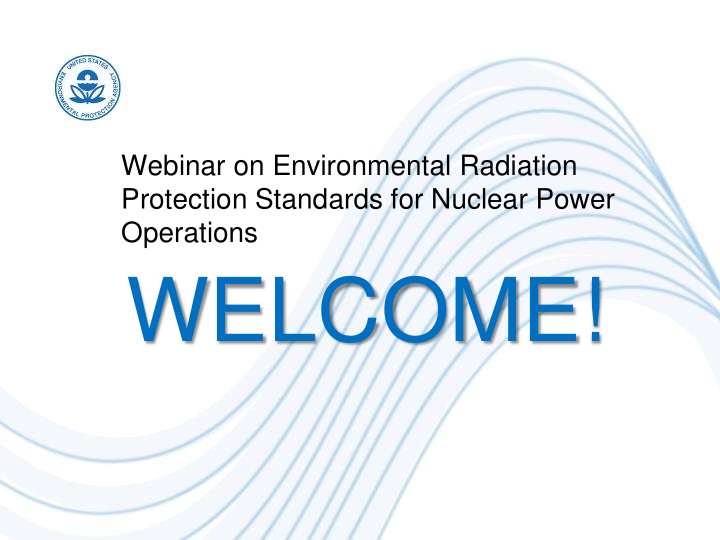



Webinar on Environmental Radiation Protection Standards for Nuclear Power Operations WELCOME!
Webinar Structure Technical presentation followed by questions and answers. Phones on mute so that everyone can hear presentation. Please submit questions in the chat room at the bottom of the screen. Comments in chat room should be courteous. 2
ANPR for Revising Environmental Radiation Protection Standards for Nuclear Power Operations Consideration of a Risk Limit Mike Boyd, US EPA May 14, 2014 Public Webinar
Presentation Outline • Background • What is a “risk limit”? • What is the existing regulatory approach? • Why might a risk limit be better? • How might a risk limit be problematic? • Issue for public comment • Summary • Discussion 4
Two main radiation protection provisions • Public Dose limits (ICRP-2 based) • 25 mrem/yr whole body, 75 mrem/yr to thyroid, and 25 mrem/yr to any other organ • Radionuclide Release limits • Annual limits on quantities of radioactivity entering the environment per Gigawatt electricity produced; primarily for reprocessing • 50,000 curies Kr-85 • 5 millicuries I-129 • 0.5 millicuries combined Pu 239 & other alpha emitters 5
What is a “risk limit”? • EPA considers health risk to the public in developing all its standards. • Dose limits correlated to health risk levels to be consistent with Agency policies. • A risk limit would state the health risk directly. • Example: “Annual risk (of developing cancer) to any member of the public shall not exceed Y x 10 -4 ”. • The risk level would likely be translated to another quantity for implementation (e.g., concentration), consistent with current practice. 6
Regulatory approach of the existing standard • EPA limits public exposure to radiation with an annual dose limit. • Because radiation exposure from nuclear fuel cycle facilities could represent a potential increased risk of cancer, a dose limit must provide an acceptable level of protection. • This level is translated to a radiation release rate, which for radiation protection is dose per time. • Compliance with the dose limit is achieved through environmental sampling or modeling. 7
Why might a risk limit be better? • Ultimately EPA’s objective is to limit the excess cancer risk • Stating the numerical objective as part of the standard provides clarity. • Public can more easily comprehend and compare the standard to other risk taking decisions. • Risk represents a judgment which should not change much over time. • The relationship between dose and risk can change over time as more information becomes available. 8
How might a risk standard present problems? • Dose (or concentration as a surrogate for dose) is a measurable quantity; risk is usually modeled. • Guidance would be needed for translating risk to a measurable quantity for implementation. • Need to choose a risk endpoint: cancer morbidity or mortality. • Industry operates in dose, both domestically and internationally, so a transition could pose problems beyond national considerations. • There could be significant costs associated with changing from dose standard to risk standard. 9
Issues for public comment • Should EPA express its limit for the purpose of this regulation in terms of radiation risk or radiation dose? • Should the Agency base any risk standard on cancer morbidity or cancer mortality? What would be the advantages or disadvantages of each? • How might a risk limit be implemented? • How might a risk standard affect other federal regulations and guidance? • Are there significant costs associated with changing to a risk standard? 10
Summary • EPA will be considering whether or not a risk standard is a better metric in its revisions to its environmental protection requirements to nuclear power operations – 40 CFR Part 190. • We will accept comments on both the technical aspects of switching to a risk standard, as well as policy issues associated with developing a risk standard. 11
Recommend
More recommend